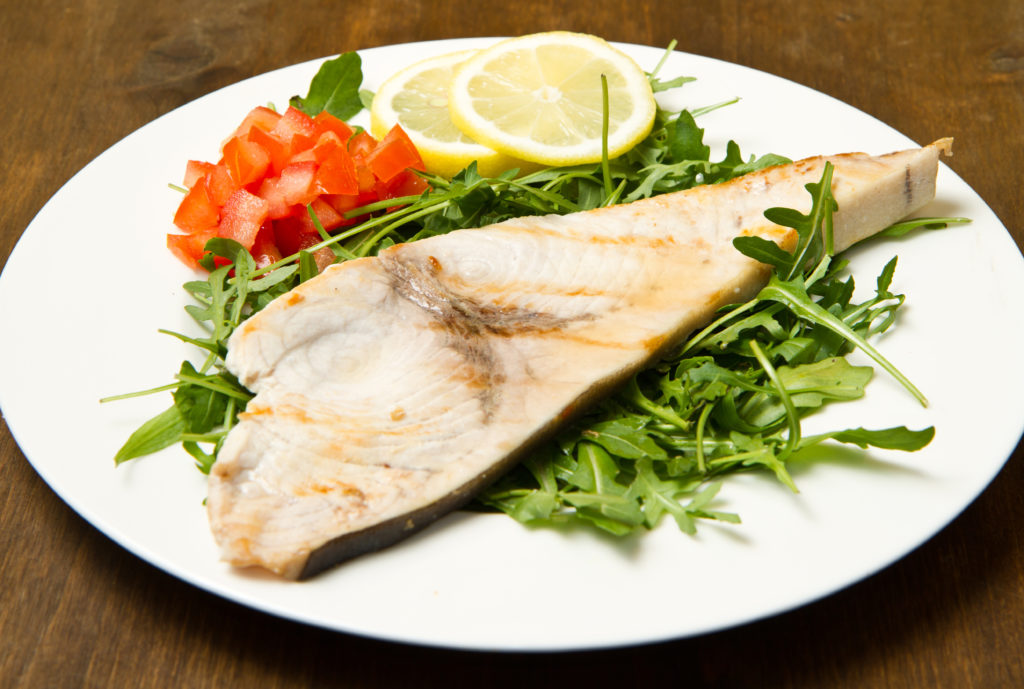Swordfish is a firm-textured meaty fish with a slightly sweet flavor. It can be made with or without the marinade, and fresh herbs are frequently used in oil-based marinades. It’s commonly cut into 1-inch (2.5-cm) fillets and grilled or cooked like a rare beef steak. Though the skin is frequently discarded because of its rubbery texture, you may wish to retain it during cooking and then discard it to assist the fish in being juicier. Boiling and stewing are two more frequent cooking processes, and Swordfish have a solid texture that prevents them from flaking or splitting apart.
While deep-frying swordfish is not a common preparation technique, it is an option. On the other hand, deep-fried foods cause the development of trans fatty acids (TFA), which may increase the risk factors for heart disease. When purchasing swordfish fillets, check for discoloration, darkening, or drying around the margins. They should also have a fresh scent, not one that is fishy or rancid. Raw swordfish can be stored in the refrigerator for up to two days before cooking or frozen for three months, and it can be kept in the fridge for up to 4 days or frozen for six months once cooked.
What is Swordfish?
The migratory predator swordfish (Xiphias gladius) can be found in the Atlantic, Indian, and Pacific oceans. Their large, flat bills (the “sword” in swordfish) protrude from their snouts, which they use to slice at prey, and their tall dorsal fins distinguish them.
Swordfish can reach 1,000 pounds in weight. However, most commercially caught swordfish weigh between 50 and 200 pounds and are sold as fillets or steaks. Swordfish steaks are perfect for grilling and pan-roasting, but be careful not to overcook them because of their low-fat content, which causes them to dry out quickly.
How to Cook Swordfish?
Swordfish is extraordinarily meaty and firm, making it ideal for fish stews, pan-searing, grilling as a complete steak, or even skewering for fish kabobs!
This beautiful fish will hold up where other fragile fish could fall apart on the grill. It’s also ideal for adding tasty marinades or sauces because of its texture and moderate flavor.
4 Ways to Cook Swordfish
Pan-Roast
In a well-seasoned cast-iron skillet or another oven-safe pan, sear swordfish until brown on one side, then flip and finish cooking in a 400°F oven.
Grill
A charcoal grill’s grates should be heated and oiled. Season swordfish with kosher salt and black pepper and rub with extra virgin olive oil for a quick marinade (10 to 15 minutes). Grill swordfish for 3 to 8 minutes per side until the outside is browned, but the inside is still somewhat pink.
Pan-Sear
3 to 8 minutes on each side, heat oil in a large skillet over medium-high heat, and sear swordfish steaks until browned on both sides and cooked through (meat should feel firm when squeezed).
Broil
Preheat the oven to broil and gently grease a broiling pan. Broil swordfish until just done, about 6 minutes, after seasoning with kosher salt and black pepper.
How to Season Swordfish?
- Gordon Ramsay’s sesame seed encrusted tuna preserves the meat during the sear while adding a nutty taste as the seeds toast. Other fish with minimal fat and no skin, such as swordfish, respond well to this approach.
- Lightly crush black, white, or green peppercorns (or all three!) to coat swordfish. This is how Wolfgang Puck prepares New York strip steaks.
- Season swordfish steaks with kosher salt and black pepper before searing them and serving them with a lemon, butter, and caper pan sauce.
- Toss swordfish, tomatoes, capers, olives, fresh lemon juice, flat-leaf parsley with spaghetti, tomatoes, capers, olives, fresh lemon juice, and flat-leaf parsley.
- Marinate swordfish in harissa or soy sauce, lemon peel, garlic cloves, herbs, and spices for 10 to 15 minutes.
- Bread crumbs sautéed in butter or olive oil are served on top of grilled swordfish steaks.
Swordfish is served with five different sauces.
How do you Know if swordfish is Done?
Feeling the swordfish steak on the exterior isn’t an excellent way to tell if it’s done, and this is because it is a firm fish that will feel equally hard at medium as it would at medium-well.
The fish should be well-browned on one side (the side you present when serving) and slightly light pink on the interior for a juicy grilled swordfish steak, but don’t worry; it will cook through by the time it reaches the table. It should also flake easily when pressed with a fork while remaining hard.
Is Swordfish a Healthy Fish to Eat?
Swordfish is a popular fish high in omega-3 fatty acids, selenium, and vitamin D, all of which are beneficial to one’s health. These nutrients have been linked to better heart and bone health and lower cancer risk in studies.
May Lower Risk Factors for Heart Disease
Heart disease is caused by high blood pressure and high cholesterol levels. Swordfish contains omega-3 fatty acids, which may help lower blood pressure and cholesterol levels, especially for those who already have cardiac problems. They don’t seem to interact with prescription medications.
EPA and DHA have been shown in studies to help decrease blood pressure by lowering heart rate and enhancing blood vessel function and flexibility. They may also help prevent blood clots from developing and blocking your arteries by lowering your blood triglycerides by 20–30%. They may, however, raise LDL (harmful) cholesterol levels, which is a risk factor for heart disease.
Swordfish also contains vitamin D, which may help lower blood pressure and reduce the risk of a heart attack. One study indicated that persons deficient in vitamin D had a 60% increased risk of heart disease. Vitamin D supplements may lower systolic blood pressure (the top number on a blood pressure reading) by 2–6 mm Hg. It could interact with various biological systems, including your kidneys and endocrine system.
May Reduce the Risk of Cancer.
Swordfish’s omega-3, vitamin D, and selenium levels may help prevent cancer. Inflammation is a cancer risk factor, and omega-3 fatty acids and vitamin D have anti-inflammatory qualities. Both minerals may help protect against colorectal cancer, according to research. Both nutrients have the potential to stop malignant cells from multiplying and cause them to die. Vitamin D may also assist in preventing the formation of new blood vessels that supply those cells.
Omega-3s also aid in preventing cancer metastasis or the spread of cancer. According to animal and human studies, they may also diminish the size of colorectal tumors. Human research, on the other hand, has shown mixed findings. On the other hand, Selenium is a potent antioxidant that fights the cancer-causing effects of free radicals in the body. It may protect against liver, prostate, breast, and lung malignancies.
Supplementing with selenium may also help persons undergoing radiotherapy improve their quality of life while reducing the adverse effects of the treatment. While the findings seem promising, it’s crucial to note that this study only looks at the impacts of specific nutrients, not the effects of eating swordfish. As a result, experts must conduct additional research into the consequences of swordfish in particular.
May Boost Bone Health
Swordfish contains vitamin D and selenium, which may help with bone health. Vitamin D’s primary function in the body is to promote calcium absorption in the intestine. It’s also essential for bone production, and a lack of it has been related to bone loss and an increased risk of falls and fractures. While selenium is less well-known than vitamin D, it also influences bone metabolism and promotes bone health. Bone cells are termed osteoclasts, and osteoclasts play a role in this process.
Osteoblasts produce bone tissue, while osteoclasts break it down to release minerals into your bloodstream in a process known as bone remodeling. Selenium helps maintain a healthy equilibrium by inhibiting osteoclast activity, which helps avoid brittle bones. In studies, low selenium blood levels have been linked to an increased risk of low bone mineral density and bone disease.
Who Should Not Eat Swordfish?
Pregnant and breastfeeding women and women of childbearing age who may become pregnant fall under this category due to the risk of passing pollutants to their children. Chemicals have a more significant impact on babies and little children.
Only two 3-ounce pieces of seafood per week, according to Frank. Pregnant women and women of reproductive age, on the other hand, are advised not to eat shark, swordfish, king mackerel, or tilefish, according to the FDA. If they consume it, they recommend doing so only once a month.
Conclusion
Swordfish is a popular fish high in omega-3 fatty acids, selenium, and vitamin D, all of which are beneficial to one’s health. These nutrients have been linked to better heart and bone health and lower cancer risk in studies. It is, however, high in mercury, a dangerous trace metal that has adverse effects on brain health, particularly in developing babies’ brains. As a result, pregnant and nursing women should avoid eating swordfish. Grilling, stewing, or boiling swordfish is delicious to prepare on occasion.
According to the US Food and Drug Administration, swordfish is rich in mercury. As a result, the FDA advises those small children, pregnant women, and people who may become pregnant to avoid using it. The Maine Sea Grant suggests that everyone else limit their swordfish consumption to two servings per month. Grill swordfish or poach it in lemon water for a healthy meal. Instead of tartar sauce, which can be high in calories and fat, serve your swordfish with homemade salsa.


